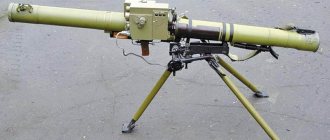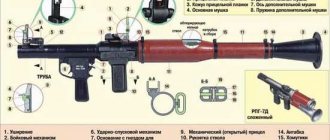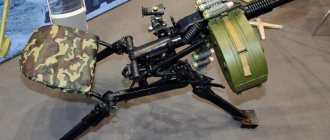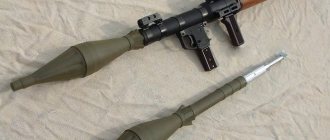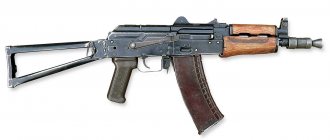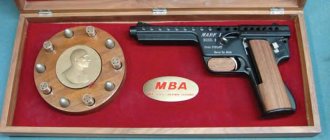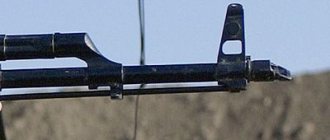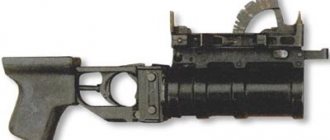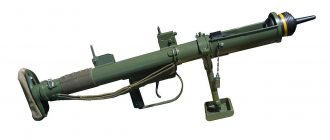What the GP-25 underbarrel grenade launcher is capable of
GP-25 underbarrel grenade launcher / Photo: EastArms.ru
In accordance with the existing classification, an under-barrel grenade launcher is a type of rifle grenade launcher located under the barrel of the main weapon.
GP-25 underbarrel grenade launcher / Photo: vpk-news.ru
Rifle grenade launchers, as a means of increasing the tactical independence and firepower of small infantry units, were created during the First World War. The first rifle grenade launchers were attached to the muzzle of the barrel and were called muzzle grenade launchers. Special blank cartridges were used to fire the grenade. In the USSR in 1928, the Dyakonov grenade launcher was adopted, which was attached to the muzzle of a 7.62 mm rifle mod. 1891/30. However, the inconvenience of its use, the low effectiveness of a remote-action fragmentation grenade, as well as the need to remove the grenade launcher before firing a live cartridge from a rifle, limited its use in combat.
In 1944-45 In the USSR, VG-44 grenade launchers for the 7.62 mm carbine mod. 1944 and VG-45 for the 7.62 mm SKS carbine. 40-mm cumulative (VPG-1) and fragmentation (VOG-1) grenades were used to fire grenade launchers. These grenade launchers were also attached to the muzzle of the carbines, and special blank cartridges were used to fire the grenade. Due to the low efficiency, and primarily the low power of grenades, these grenade launcher systems are not widely used.
Before World War II, rifle grenades were also created in the USSR. In 1941, the Serdyukov VPGS-41 ramrod-type anti-tank rifle grenade of the Serdyukov system entered service. However, due to the unreliability and unsafety of the grenade, as well as the low accuracy of fire, it was already withdrawn from service in 1942. Assessing the listed developments, it should be noted that one of the main problems not solved at that time was the creation of a reliable and effective grenade in a small caliber, determined by the weight and size requirements for portable weapons.
The first experiments to create a new combined multi-purpose weapon without the disadvantages of muzzle grenade launchers and rifle grenades began in the USSR in the early 1960s. Similar work was carried out at this time in the USA.
An employee of the Central Design Bureau of Sports and Hunting Weapons (TsKIB SOO, Tula) K.V. Demidov proposed a new two-stage ballistic design for an under-barrel grenade launcher. The essence of the proposal was that in the bottom of the grenade there was a shank with a propellant charge of smaller diameter than the grenade itself. The shank, like a piston, was inserted into the high-pressure chamber of the grenade launcher. The pressure in this chamber was several times higher than the pressure in the caliber part of the barrel, which made it possible to increase the loading density, ensure early combustion of the propellant charge and stable shot characteristics.
Russia conducted an experiment using a “swarm” of fighters
Work on the creation of the first domestic under-barrel grenade launcher was started on an initiative basis at TsKIB SOO in 1965 by K.V. Demidov together with V.V. Rebrikov. The manufactured prototypes were demonstrated to representatives of the USSR Ministry of Defense, and in April 1967, the Iskra research and development work began to develop a “Firing device and shot with a fragmentation-cumulative grenade for the AKM assault rifle.” Also, TsKIB SOO carried out preliminary design studies of a 40-mm cumulative fragmentation round.
However, the required characteristics in terms of grenade power and shooting accuracy were not achieved, and work on the Iskra design and development project was stopped. The reasons for the failure were incorrectly specified requirements for the grenade launcher system and the not entirely successful design of the grenade itself.
However, the positive experience of using this type of weapon by the US Army in Vietnam forced the resumption of work. The Ministry of Defense assigned the designers the task of creating a weapon superior in a number of indicators to the American M203 under-barrel grenade launcher.
As a result, in 1971, development work “Koster” was started to create an under-barrel complex with a fragmentation grenade. The lead developer of the complex and the under-barrel grenade launcher was identified as TsKIB SOO, the lead developer of shots was NPO Pribor, the developer of fuses for grenades was the Scientific Research Technological Institute, the developer of propellant and expelling charges was Kazan NIIHP.
The transfer of the development of ammunition for a new grenade launcher complex to a specialized enterprise ultimately determined the success of the promising development.
As a result of the implementation of the Koster R&D project, a grenade launcher system was created and adopted by the Soviet Army in 1978, consisting of a 40-mm GP-25 grenade launcher (leading designer V.N. Telesh) and rounds for it with a VOG-25 fragmentation grenade and with a VOG-25P fragmentation “bouncing” grenade. The grenade launcher is mounted under the barrel of the AKM, AKMS, AK74 and AKS74 assault rifles.
The grenade launcher has a rifled barrel. The self-cocking trigger mechanism of the grenade launcher ensures high combat readiness of the complex and safety of carrying when loaded. Flag-type safety locks the trigger when turned on. For ease of handling the grenade launcher, a pistol-type handle is attached to the body of the trigger mechanism. The grenade launcher is loaded from the muzzle, and unloaded by pressing the extractor. The grenade is held in the barrel by a spring-loaded retainer, which at the same time serves as a safety device when the grenade is not fully loaded into the barrel.
The muzzle loading of the grenade launcher, as well as the absence of a cartridge case, allows for up to 6 aimed shots per minute. An open-type sighting device is located on the left side of the grenade launcher and provides direct and semi-direct fire (along a hinged trajectory). When shooting along a mounted trajectory at unobserved targets (in trenches, ravines or on reverse slopes), the required elevation angle of the weapon is given according to the plumb line of the sight. The derivation of the grenade is taken into account in the sight automatically when installing the sight.
A rubber butt pad is installed on the butt of the machine gun to weaken the impact of the grenade launcher’s recoil on the shooter’s shoulder, as well as to reduce the forces perceived by the butt when shooting against hard ground.
Unlike the American prototype, when developing the Soviet grenade launcher system, the designers, not being associated with the old ammunition, decided to create a shot of a fundamentally new design based on the proposals of K.V. Demidov.
The two-chamber ballistic engine, which forms the grenade shank and the breech of the grenade launcher, provided, with an almost identical initial shot speed to the American counterpart, reduced recoil and the possibility of increasing the mass of the fragmentation grenade. In addition, placing the propellant charge in the shank of the grenade eliminated such an operation as extracting the spent cartridge case. After the next shot, the shooter must only take out the next grenade from the bag, insert it into the muzzle of the grenade launcher and push it all the way into the barrel.
A new version of Iskander-M is being prepared
Ammunition of the GP-25 underbarrel grenade launcher / Photo: vpk-news.ru
The production of the grenade launcher was mastered by the Tula Arms Plant. Infantrymen armed with rifle-grenade launcher systems were able to engage manpower and fire weapons not only openly located, but also located in open field shelters and behind various obstacles. The subsequent creation, in addition to fragmentation grenades, of other types of grenades for various purposes and destructive effects significantly expanded the infantry’s capabilities to defeat the enemy.
The VOG-25 40mm fragmentation grenade round has a grenade with protrusions on the driving belt. This made it possible to stabilize the flight of the grenade by rotation, without creating excessive pressure in the barrel bore, and to make the grenade launcher relatively light. Head impact fuse with long-range cocking (10–40 m from the muzzle) and self-destruction. It ensures safe handling of the grenade during transportation and its immediate detonation when it hits an obstacle. The radius of continuous destruction by fragments resulting from the organized crushing of the hull is 6 m.
In addition to the VOG-25 shot, in order to increase the effectiveness of defeating manpower in open structures and terrain hidden behind shelters, a shot with a “bouncing” grenade, the VOG-25P, was developed and adopted for service. When it hits the ground and the fuse is triggered, a special charge is detonated. He throws the grenade to a height of 0.5–1.5 m, where the main charge is detonated. When a grenade explodes in the air, the density of the fragmentation field and the probability of hitting the target increases significantly.
In the early 2000s, NPO Pribor developed modernized VOG-25M and VOG-25PM rounds to replace the VOG-25 and VOG-25P rounds. They have a new unified body with organized crushing during detonation. The number of fragments and their energy provide a 1.5 times greater probability of hitting living targets than that of VOG-25 grenades. The VOG-25PM grenade, like the VOG-25P grenade, has a special charge that ensures that the grenade is thrown above the ground before detonation.
Ammunition of the GP-25 underbarrel grenade launcher / Photo: vpk-news.ru
The fuse mechanism of the new grenades ensures that they are cocked 10–40 m from the muzzle of the grenade launcher and are reliably detonated when encountering various obstacles, including snow and water. If the fuse fails to fire within 14–19 s, the grenade self-destructs. The fuse ensures safe handling of a grenade loaded into a grenade launcher.
To increase the tactical independence of small infantry units and to perform special tasks by various law enforcement agencies, which are armed with under-barrel grenade launchers, in the first decade of the 2000s, in the Federal State Unitary Enterprise "FNPTs" Pribor" and in the Scientific Research Institute of Applied Chemistry (NIIPH, Sergiev Posad) a range of ammunition for various special purposes was created - shots with high-explosive, thermobaric, incendiary, light-sound, illumination and signal grenades. VFG-25 rounds with a high-explosive and VG-40TB with a thermobaric warhead ensure the defeat of an enemy located in open areas, in field-type shelters, in various rooms, in fortifications and behind natural obstacles. In addition, they can reliably destroy unarmored vehicles. The peculiarity of the action of these grenades is that they have a multifactorial attack: high-explosive, fragmentation and incendiary. This ensures their high efficiency in destroying enemy personnel and unarmored targets. To create smoke screens in open areas, in front of natural and artificial shelters, as well as to create fires on the ground, indoors and in unarmored vehicles containing combustible and flammable materials, 40-mm VZG-25 incendiary rounds, VG-40DZ, were developed with smoke-incendiary grenades and smoke-generating GD-40. One VZG-25 grenade can provide at least 3 fires, with a combustion temperature of up to 2,000°C. The VG-40DZ grenade provides a continuous smoke screen up to 5 m long and up to 2.5 m high. In addition, up to 10 fires can be created by firing one grenade. The firing range of these grenades ranges from 50 to 400 meters. ZRPK "Pantsir-SM"
To instantly create a smoke screen in case of need to hide the maneuver of friendly units, a GDM-40 shot with an instant smoke grenade was created. This grenade provides within 1...2 seconds after the shot the formation at a distance of 40...50 m of a continuous aerosol-smoke cloud measuring up to 10 m in length and up to 3 m in height. The lifetime of the cloud is 20...30 s, which is quite enough to maneuver and escape from enemy fire. Temporary neutralization of the enemy is ensured by the explosion of light-sound grenades VG-40SZ and GZS-40. A living target is hit with a bright, blinding flash and a high sound level. At a distance of 10 m from the grenade explosion site, the sound level is at least 135 dB. The simultaneous influence of these two factors ensures a temporary loss of orientation and suppression of a person’s psycho-volitional stability. To provide light and sound signals and illuminate the area when firing from under-barrel grenade launchers, combined shots with a signal cartridge, a special signal cartridge, non-parachute illumination and parachute cartridges were developed. The combined signal cartridge for an underbarrel grenade launcher is designed for simultaneous delivery of color fire and reflected radar signals. After firing from such a cartridge, a bright red star lights up at an altitude of 300 m, the burning time of which is at least 6 seconds. In addition, when the cartridge is triggered, a cloud of radio-reflecting dipoles with an area of at least 10–12 m2 is formed. This cloud ensures reception of the reflected radio signal at a distance of at least 10–12 km. The burning star can be seen with the naked eye in the daytime at a distance of up to 3 km, and at night - almost 10 km away.
The signal cartridge provides a red or green signal. The sprocket lifting height is up to 200 m, the burning time is at least 10 s. Such a signal is visible during the day at a distance of up to 3 km and at night up to 10 km. To ensure illumination of the area and illumination of targets at night, special parachute and non-parachute lighting cartridges have been developed. Their main difference is the duration of illumination of the area, the range and height of the torch. Both types of lighting sockets provide an area illumination radius of up to 250 m with an illumination level of at least 1 lux. The torch setting range for a non-parachute lighting and parachute lighting cartridge is 200 and 400 m, respectively, and for an extended-range parachute lighting cartridge is 500, 800 and 1200 m. The area illumination time for a parachute-free cartridge is at least 9 s, and for a parachute cartridge - at least 20 s. For training, VOG-25 rounds with an inert grenade or a practical VUS-25 round are used. The practice shot can also be used for target designation. To do this, it has a smoke charge, which within 10–15 seconds ensures the formation of a cloud of red-orange smoke. Their ballistics are consistent with live grenades. The GP-25 underbarrel grenade launchers, starting with purely anti-personnel missions, became an indispensable fire weapon for infantry squads. Their main tactical purpose in combined arms combat, with a firing range of up to 400 m, is to cover the zone inaccessible to throwing a hand grenade to the line of safe removal from the explosions of friendly artillery shells. The recent creation of a whole range of special ammunition for various purposes has significantly expanded their capabilities and made them in demand in special units of law enforcement agencies. Today, GP-30M and GP-34 grenade launchers are being replaced by GP-25 grenade launchers in various security forces. All of the listed types of grenades are used to fire them.
MOSCOW, “All-Russian weekly newspaper of the military-industrial complex”, Victor Korablin 12
Subscribe to us on VKontakte
Comparison with M203
In 1978, comparative tests of the GP-25 grenade launcher with the VOG-25 round and the 40-mm M203 under-barrel grenade launcher with the M-406 round mounted on the M16A1 rifle were carried out. Tests have shown a significant advantage of the Soviet grenade launcher and its shot over a similar US-made system. The VOG-25 and M-406 shots were compared by firing at an area where a target environment was located, simulating openly located manpower (lying growth targets). During these tests, it was revealed that the frequency of hitting targets on the tactical field from the explosion of a grenade from a VOG-25 round is 3–4 times higher than from the explosion of a fragmentation grenade from an M-406 round[1].
